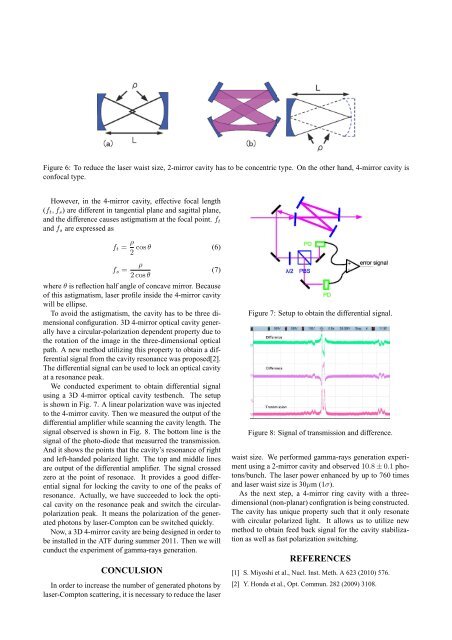Proceedings of International Conference on Physics in ... - KEK
Proceedings of International Conference on Physics in ... - KEK
Proceedings of International Conference on Physics in ... - KEK
Create successful ePaper yourself
Turn your PDF publications into a flip-book with our unique Google optimized e-Paper software.
Figure 6: To reduce the laser waist size, 2-mirror cavity has to be c<strong>on</strong>centric type. On the other hand, 4-mirror cavity is<br />
c<strong>on</strong>focal type.<br />
However, <strong>in</strong> the 4-mirror cavity, effective focal length<br />
(ft, fs) are different <strong>in</strong> tangential plane and sagittal plane,<br />
and the difference causes astigmatism at the focal po<strong>in</strong>t. ft<br />
and fs are expressed as<br />
ft = ρ<br />
cos θ (6)<br />
2<br />
fs = ρ<br />
2 cos θ<br />
where θ is reflecti<strong>on</strong> half angle <str<strong>on</strong>g>of</str<strong>on</strong>g> c<strong>on</strong>cave mirror. Because<br />
<str<strong>on</strong>g>of</str<strong>on</strong>g> this astigmatism, laser pr<str<strong>on</strong>g>of</str<strong>on</strong>g>ile <strong>in</strong>side the 4-mirror cavity<br />
will be ellipse.<br />
To avoid the astigmatism, the cavity has to be three dimensi<strong>on</strong>al<br />
c<strong>on</strong>figurati<strong>on</strong>. 3D 4-mirror optical cavity generally<br />
have a circular-polarizati<strong>on</strong> dependent property due to<br />
the rotati<strong>on</strong> <str<strong>on</strong>g>of</str<strong>on</strong>g> the image <strong>in</strong> the three-dimensi<strong>on</strong>al optical<br />
path. A new method utiliz<strong>in</strong>g this property to obta<strong>in</strong> a differential<br />
signal from the cavity res<strong>on</strong>ance was proposed[2].<br />
The differential signal can be used to lock an optical cavity<br />
at a res<strong>on</strong>ance peak.<br />
We c<strong>on</strong>ducted experiment to obta<strong>in</strong> differential signal<br />
us<strong>in</strong>g a 3D 4-mirror optical cavity testbench. The setup<br />
is shown <strong>in</strong> Fig. 7. A l<strong>in</strong>ear polarizati<strong>on</strong> wave was <strong>in</strong>jected<br />
to the 4-mirror cavity. Then we measured the output <str<strong>on</strong>g>of</str<strong>on</strong>g> the<br />
differential amplifier while scann<strong>in</strong>g the cavity length. The<br />
signal observed is shown <strong>in</strong> Fig. 8. The bottom l<strong>in</strong>e is the<br />
signal <str<strong>on</strong>g>of</str<strong>on</strong>g> the photo-diode that measurred the transmissi<strong>on</strong>.<br />
And it shows the po<strong>in</strong>ts that the cavity’s res<strong>on</strong>ance <str<strong>on</strong>g>of</str<strong>on</strong>g> right<br />
and left-handed polarized light. The top and middle l<strong>in</strong>es<br />
are output <str<strong>on</strong>g>of</str<strong>on</strong>g> the differential amplifier. The signal crossed<br />
zero at the po<strong>in</strong>t <str<strong>on</strong>g>of</str<strong>on</strong>g> res<strong>on</strong>ace. It provides a good differential<br />
signal for lock<strong>in</strong>g the cavity to <strong>on</strong>e <str<strong>on</strong>g>of</str<strong>on</strong>g> the peaks <str<strong>on</strong>g>of</str<strong>on</strong>g><br />
res<strong>on</strong>ance. Actually, we have succeeded to lock the optical<br />
cavity <strong>on</strong> the res<strong>on</strong>ance peak and switch the circularpolarizati<strong>on</strong><br />
peak. It means the polarizati<strong>on</strong> <str<strong>on</strong>g>of</str<strong>on</strong>g> the generated<br />
phot<strong>on</strong>s by laser-Compt<strong>on</strong> can be switched quickly.<br />
Now, a 3D 4-mirror cavity are be<strong>in</strong>g designed <strong>in</strong> order to<br />
be <strong>in</strong>stalled <strong>in</strong> the ATF dur<strong>in</strong>g summer 2011. Then we will<br />
cunduct the experiment <str<strong>on</strong>g>of</str<strong>on</strong>g> gamma-rays generati<strong>on</strong>.<br />
CONCULSION<br />
In order to <strong>in</strong>crease the number <str<strong>on</strong>g>of</str<strong>on</strong>g> generated phot<strong>on</strong>s by<br />
laser-Compt<strong>on</strong> scatter<strong>in</strong>g, it is necessary to reduce the laser<br />
(7)<br />
Figure 7: Setup to obta<strong>in</strong> the differential signal.<br />
Figure 8: Signal <str<strong>on</strong>g>of</str<strong>on</strong>g> transmissi<strong>on</strong> and difference.<br />
waist size. We performed gamma-rays generati<strong>on</strong> experiment<br />
us<strong>in</strong>g a 2-mirror cavity and observed 10.8 ± 0.1 phot<strong>on</strong>s/bunch.<br />
The laser power enhanced by up to 760 times<br />
and laser waist size is 30µm (1σ).<br />
As the next step, a 4-mirror r<strong>in</strong>g cavity with a threedimensi<strong>on</strong>al<br />
(n<strong>on</strong>-planar) c<strong>on</strong>figrati<strong>on</strong> is be<strong>in</strong>g c<strong>on</strong>structed.<br />
The cavity has unique property such that it <strong>on</strong>ly res<strong>on</strong>ate<br />
with circular polarized light. It allows us to utilize new<br />
method to obta<strong>in</strong> feed back signal for the cavity stabilizati<strong>on</strong><br />
as well as fast polarizati<strong>on</strong> switch<strong>in</strong>g.<br />
REFERENCES<br />
[1] S. Miyoshi et al., Nucl. Inst. Meth. A 623 (2010) 576.<br />
[2] Y. H<strong>on</strong>da et al., Opt. Commun. 282 (2009) 3108.













